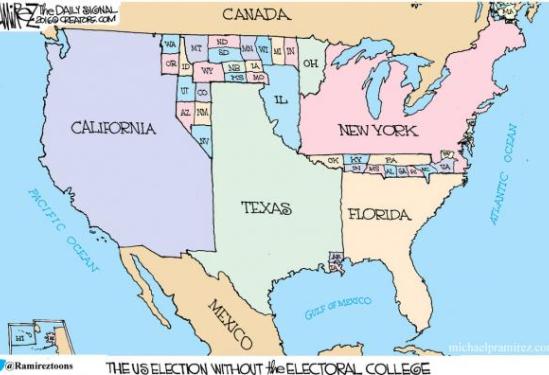Electoral College Myth #7: The System Disenfranchises Voters Who Live in “Safe” States
Myth number 7 in my series on Electoral College Myths! Please don’t miss the earlier installments here:
Myth #1: Only swing states matter, other states are ignored
Myth #2: The Founders did not trust the people
Myth #3: The Electoral College is undemocratic
Myth #4: Votes cast for a 3rd-party candidate are wasted
Myth #5: Eliminating the Electoral College will make it harder to steal elections
Myth #6: Eliminating the Electoral College would make every vote equal
Myth: Most voters don’t count in presidential elections. The winner-take-all allocation of electoral votes in the states ensures that some voters are disenfranchised, left on the sidelines to watch, as voters in swing states determine the outcome of the election. Why bother to cast a Democratic vote in Texas or a Republican one in California? These are wasted votes.
Fact: To “disenfranchise” is to take away a person’s right to vote. No one in this country is losing his right to cast a ballot. This is a strong (and baseless) allegation that reflects a fundamental misunderstanding of our Electoral College system works today.
America’s presidential election process occurs in two phases: The first phase is a series of state-level elections that occurs on Election Day. We conduct 51 of these elections: one in each state and one in the District of Columbia. The purpose of these 51 elections is to determine who will represent each state in the second phase of the election: an election among the states. This second phase of the election occurs in December and will be a mere blip on the media’s radar.
Each of the 51 elections conducted on Election Day is a purely democratic election; every voter in every state retains his right to cast a ballot. Of course, as in any other election, there will be winners and there will be losers. The losers are not disenfranchised. They simply cast a ballot on the losing side of an election.
Let’s say it another way: If you are a Republican casting your ballot in California, you will probably be on the losing side of the state-level election in California. More than likely, Hillary Clinton will carry California and obtain its 55 electoral votes. However, California Republicans are most emphatically not being disenfranchised. They are simply losing the election, just as they lost the last gubernatorial election. Their problem is not with the Electoral College. Their problem is a general one about how the Republican Party’s message is being received around California.
By the way, this can change. As recently as 1988, California was voting safely RED, not BLUE. And this year’s election is already disrupting many long-held assumptions about how states will vote.
Finally, remember that the winner-take-all system is not mandated by the Constitution. If a state wants to change to a different system of electoral allocation, it is welcome to do so. In fact, Maine and Nebraska have already made such a change. Their votes are allocated based upon congressional district.
To be fair, it should be noted that the state legislature does retain the right to select the electors on its own, without reference to a popular vote. Historically, this has only occurred in special circumstances. For instance, the Colorado legislature directly selected electors in 1876, shortly after it became a state. It had just held elections for its statewide offices in August, and it did not want to go to the expense of another election so soon. Similarly, in 2000, the Florida state legislature was prepared to appoint electors directly if disputes over its state’s ballots could not be resolved.
As a general matter, however, those few instances have been the exception, not the rule. Allegations that voters are being “disenfranchised” by the Electoral College are mere melodrama. America conducts 51 purely democratic elections each and every presidential election year; every voter in these elections retains his right to participate fully. What Electoral College opponents really mean by their claims of “disenfranchisement” and “waste” is that they feel emotionally better about one national, democratic election than 51 state-level, democratic elections.
For a discussion of the reasons that our Founders combined state action with democracy, please see my post on the subject, here.
Please don’t miss my new kids’ illustrated book about the Electoral College!
Signed copies available at the bottom of THIS PAGE.
If you have Amazon Prime, shipping will be much cheaper with (unsigned) copies HERE.
This entry was posted in Electoral College resources. Bookmark the permalink.

